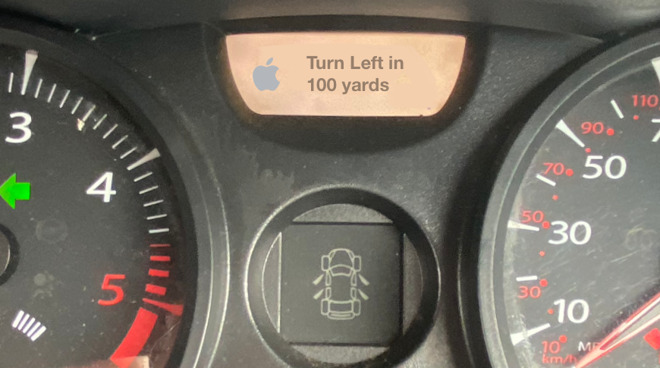Instead of CarPlay stuck on a separate display on a vehicle's head unit, Apple is working on integrating CarPlay into a car's regular dashboard -- and it may be a hint at how Apple itself may implement it in the Apple Car.

Future CarPlay versions will take over a car's own dashboard displays and fit navigation instructions there.
While CarPlay saw its first major overhaul with iOS 13 in 2019, future versions may look radically different. A new patent application shows Apple looking to integrate CarPlay much more deeply into cars. To present its navigation information, especially, to drivers in the most useful, and least distracting way, future CarPlay may display its information in the car's regular dashboard controls.
"Instrument cluster metadata to support second screen," US Patent No 10,594,850, describes both the intention of keeping a driver's attention better focused, and also what CarPlay will have to do to achieve this.
"Over the past decade, user handheld device deployment such as the iPhone... have grown rapidly," says the patent, "The accuracy, functionality, and usability of navigation applications have made them some of the most used applications on handheld device platforms."
"However, barriers and limitations to a very desired use case, automobile navigation, persist," it continues. It describes how even when it's legal to hold an iPhone while driving, it is dangerous and cumbersome. "Past attempts at resolving these problems have involved interfaces to connect to head units in automobiles. However, this approach still can lead to the driver removing his [or her] visual focus from what is occurring in front of the car, and placing it on the head unit."
Under the new proposal, CarPlay will first of all either interrogate the car's systems for details, or more likely work from manufacturer-supplied information. In either case, it will be looking for what displays the car's dash already has, and then specific details about each one.
The current CarPlay using iOS 13. There's nothing wrong with that, but this display is to the right of the steering wheel, and so takes the driver's attention off the road.
CarPlay will look for what fonts are used by the car, what the character size and width limits are, plus what graphics capability they have.
"Based on instrument cluster display capabilities, the smart phone packages metadata, including formatting information specific to the display on the instrument cluster, in order to indicate to the driver an upcoming navigation change," continues the patent.
"This includes formatting turn by turn navigations, distance until next turn, estimated time until next turn, and instructing them to load an appropriate graphic," it says.
This still requires the driver to look at the dashboard, so it isn't as conducive to keeping one's eyes on the road as a windscreen-projected heads-up display would be. However, it's significantly better than having to look to one side to a separate screen. Not only does it require less head and eye movement, but the driver is already used to registering information on the dash as he or she drives.
"The instrument cluster may be situated just beneath the driver's focus during operation so that when the driver needs feedback from the vehicle, the instrument cluster is in the optimal place for viewing without necessitating losing focus on the road in front of the vehicle," concludes the patent.
The majority of the patent description details how the most basic navigation could work, and how it needs to present relatively little information to the driver at any one time. Turn by turn details can be described in a few text characters, for instance, or perhaps with just an arrow.
Detail from the patent showing that navigation detail from an iPhone can be routed to one display showing just icons (top left), or full graphics (top middle)
Lane control needs more and so do options like rerouting for traffic, and recent additions such as sharing ETA. Depending on the car and its dashboard displays, CarPlay may be able to utilize any part of that to show extra information. It's more likely, though, that some kind of second display will be needed.
This could be the same kind of navigation or entertainment control screen we commonly see today, but CarPlay may route specific information to different types of display all at the same time. That can include these separate screens, the car's own dashboard ones -- or a heads-up display.
"[The] instrument cluster may contain a secondary display... [which] may be embedded in the center of the instrument cluster," says the patent. "Alternatively, the secondary display may be located outside of the instrument cluster. The secondary display may be of varying capability. [It] may be only capable of displaying text [or] displaying graphics in addition to text. One example of a secondary display outside of the instrument cluster include heads-up displays (HUDs)."
Achieving all of this requires the cooperation of car manufacturers, and Apple is likely to get that simply because of how many already support the current version of CarPlay. The one manufacturer it is certain to get doing this, though, is Apple itself.
As well as a useful addition for future versions of CarPlay in any car, this patent is a interesting insight into how Apple may be planning to use it in the forthcoming Apple Car. Previous patents have suggested that the Apple Car may even control CarPlay through a smart seatbelt.
The patent is credited to three inventors -- Joshua C. Weinberg, Thomas R. Powell, and David Rix Nelson. Weinberg has previous related patents such as ones on "Map application with improved navigation tools," and "Hierarchy of tools for navigation."


